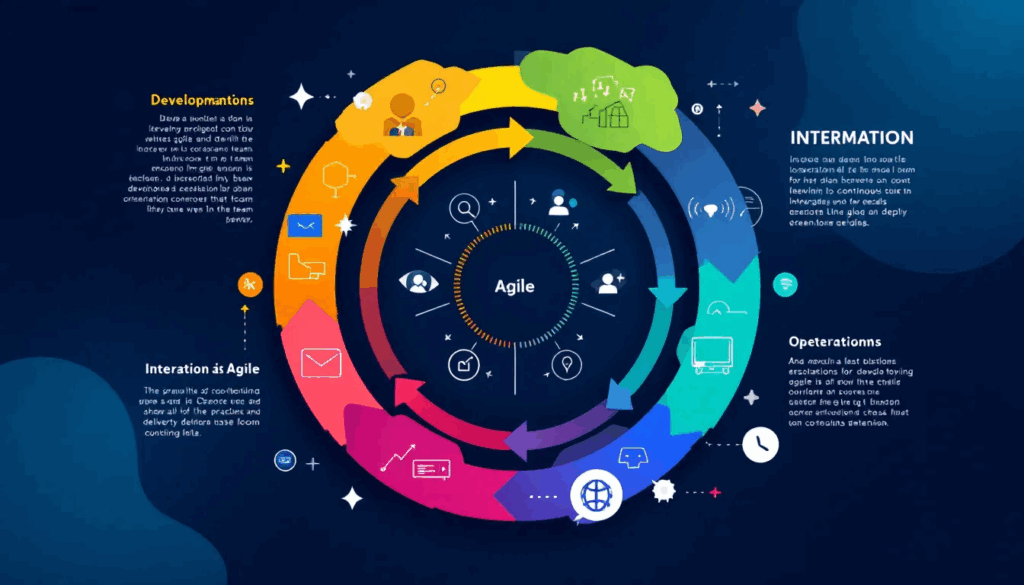Collaboration between development and operations teams is essential for efficient and high-quality software delivery. This article explores practical strategies on how to foster collaboration between development and operations teams. From breaking down silos to leveraging automation, you’ll find actionable tips to enhance teamwork and streamline processes.
Breaking Down Silos
Breaking down silos is key to fostering collaboration between development and operations teams. Isolation leads to delays and errors in the product development lifecycle. Collaboration removes these boundaries, promoting holistic contributions and ensuring everyone works towards a common goal.
Cross-functional teams are essential for this approach. Creating units that include both developers and operations personnel leads to quicker product delivery, better software quality, and higher employee morale. Shared responsibility and collaboration in a DevOps culture improve overall efficiency and quality.
Promoting continuous learning and collaboration helps overcome resistance to change. When teams understand the value of working together and have the right skills, they embrace new processes and tools more readily. Breaking down silos ultimately paves the way for a cohesive and effective DevOps environment.
Streamlining Communication Channels
Effective communication is vital for successful DevOps teams. Shared tools that enhance communication and transparency foster collaboration. Tools like Slack, Microsoft Teams, and Zoom significantly improve communication among remote teams, ensuring everyone stays connected and informed.
Shared dashboards offer several advantages:
- Provide real-time insights into system health, promoting collaboration.
- Enhance transparency, allowing teams to monitor project status and address issues promptly.
- Integration with monitoring systems and incident management platforms streamlines the process of handling and resolving incidents.
Regular updates through asynchronous formats, such as podcasts, enhance information dissemination in remote settings. This ensures all team members are on the same page, regardless of location. Streamlined communication in DevOps prevents misunderstandings and speeds up issue resolution, leading to improved software quality and customer satisfaction.
Daily stand-up meetings keep teams in sync on projects. Shared dashboards and real-time monitoring tools support this goal, ensuring everyone is aligned and working towards the same objectives. Streamlining communication channels enhances collaboration and drives better outcomes.
Implementing Continuous Feedback Loops
Continuous feedback loops are crucial for improving project success and facilitating proactive issue resolution. Key aspects include:
- Identifying issues early and addressing them quickly to significantly enhance project outcomes.
- Using real-time feedback mechanisms, such as automated tools for feedback collection.
- Streamlining the feedback process and enhancing collaboration efficiency.
Feedback should be actionable and specific to drive meaningful improvements. Incorporating it into regular team retrospectives fosters a learning environment where continuous improvement is encouraged. Open communication promotes transparency in sharing suggestions and concerns.
Incorporating continuous feedback into development cycles enables teams to adapt quickly to changes and deliver high-quality products. This iterative development approach ensures continuous integration of customer feedback, leading to better alignment with market demands. Continuous feedback loops are essential for maintaining a high-performing DevOps culture within the software development lifecycle.
Promoting a Culture of Accountability
Fostering a culture of shared accountability is crucial for enhancing collaboration between development and operations teams. Shared responsibility in DevOps enhances collaboration and minimizes delays, promoting commitment to quality. Focusing on positive actions rather than assigning blame cultivates a sense of ownership and accountability.
Motivation, trust, and accountability are key psychological factors in a successful growth mindset DevOps culture. Empowering team members to take ownership and address challenges fosters accountability. The process involves recognizing challenges, taking ownership, and collectively finding solutions.
The Results Pyramid framework helps teams evaluate their culture and drive meaningful changes, ultimately leading to a culture of accountability that enhances collaboration, improves efficiency, and leads to high-quality software delivery.
Leveraging Automation Tools

Automation and continuous integration and continuous deployment are central to DevOps, reducing waiting times among teams. Key benefits include:
- Automation enables faster software delivery by reducing manual tasks and minimizing errors.
- Startups can leverage automation tools to compete effectively.
- Increased deployment speeds.
- Maintaining system reliability without excessive resource investment. DevOps automation enhances these processes within the devops pipeline and provisioning infrastructure devops eliminates inefficiencies.
Automated processes offer several advantages:
- Enhance reliability and scalability, allowing systems to manage increasing workloads without significant manual input.
- Ensure consistency across deployments through standardized automation practices, minimizing environment discrepancies.
- Maintain high deployment frequency via automated deployment pipelines, automatically deploying code, streamlining processes, automating repetitive tasks, infrastructure management, including repetitive tasks, automating processes, traditional workflows, and deployment processes.
Automated monitoring tools offer several advantages:
- Detect and react to issues in real-time, significantly improving response times.
- Use advanced analytics and machine learning to identify anomalies in monitoring data, allowing for proactive incident prevention.
- Enhance collaboration, improve software quality, and streamline processes by leveraging automation tools.
Encouraging Continuous Learning and Skill Development
Continuous learning is essential for DevOps teams to adapt to changing business needs and technologies. Effective training programs include:
- In-person courses offering certifications to enhance team skills
- Online courses offering certifications to enhance team skills Knowledge sharing can be facilitated through:
- Self-service knowledge bases
- Collaboration platforms
A culture of experimentation allows teams to discover effective devops practices and adapt quickly. Ongoing training and collaboration are key to maintaining high productivity in DevOps environments. Fostering continuous learning and skill development promotes collaboration in a collaborative environment and drives continuous improvement.
Creating Shared Metrics and Goals
Creating shared goals unifies teams and enhances ownership of the development process. DevOps processes metrics provide crucial insights into the performance and efficiency of software development processes, including key metrics such as deployment frequency and lead time for changes.
For continuous improvement, teams must:
- Regularly assess and refine their performance metrics.
- Establish shared metrics to reduce the likelihood of misaligned priorities between development and operations teams.
- Create shared metrics and goals to promote collaboration and drive better outcomes.
Utilizing Monitoring Tools for Proactive Issue Resolution
DevOps promotes observability by:
- Allowing all teams to access real-time monitoring data and enhance issue resolution.
- Providing real-time alerts that notify teams of anomalies as soon as they occur, minimizing potential disruptions.
- Centralizing logs into a unified system, simplifying the search and analysis of events, and enhancing issue resolution efficiency.
Structured logging formats, like JSON, make logs easier to parse and analyze, aiding in issue identification and helping teams identify areas for improvement. Key security practices include:
- Identifying and consistently tracking key performance indicators reflecting system health.
- Utilizing monitoring tools to allow teams to address issues proactively.
- Improving collaboration and software quality through these practices, including security testing and logging tools.
Fostering Open Communication and Shared Ownership
High-performing DevOps cultures thrive on:
- Trust and transparency, which are essential for effective communication.
- Establishing effective communication channels to streamline workflows between development and operations.
- Encouraging informal interactions to strengthen relationships and improve collaboration between teams, guided by devops principles.
A culture of shared ownership and continuous improvement is essential for fostering a DevOps culture. Promoting open communication and shared ownership enhances collaboration, streamlines processes, and drives better outcomes.
Adopting Agile Practices for Seamless Collaboration

Agile methodologies promote collaboration, agility, and efficiency, helping development and operations teams respond quickly to market demands. Practices like Scrum and Kanban emphasize flexibility, customer collaboration, and rapid delivery of improvements. Focusing on automation and continuous integration through Agile allows teams to deploy and respond to changes promptly.
Pair programming is an effective Agile practice that enhances collaboration and expedites project completion. Teams integrating Agile methodologies with DevOps can significantly increase deployment frequency and enhance collaboration. Collaboration between development and operations teams and qa teams accelerates development cycles, enabling faster features and improved services while deploying code. Additionally, remote collaboration can further streamline these processes.
Implementing Agile practices within organizations reduces deployment times and increases customer satisfaction. Adopting Agile practices achieves seamless collaboration and drives continuous improvement.
Final thoughts
In conclusion, fostering collaboration between development and operations teams requires a multifaceted approach that combines cultural change, effective communication, continuous feedback, automation, and shared accountability. By breaking down silos, embracing Agile and DevOps principles, and promoting continuous learning, organizations can create an environment where teams work seamlessly together. The result is faster delivery cycles, higher software quality, improved resilience, and greater customer satisfaction — all of which position the business for long-term success.



